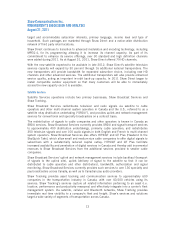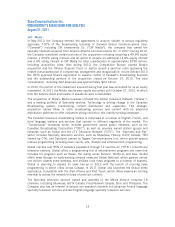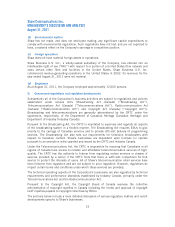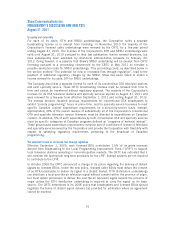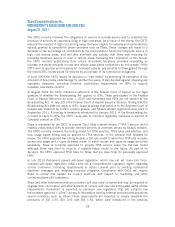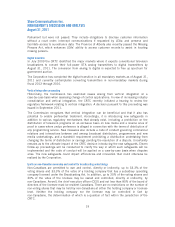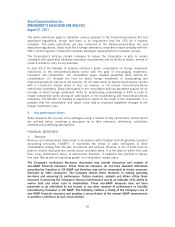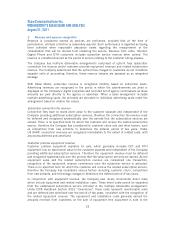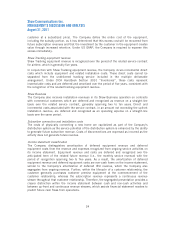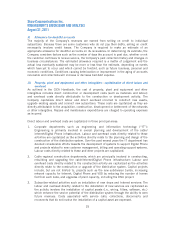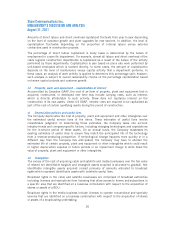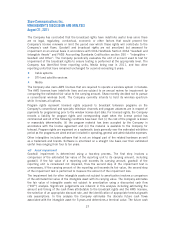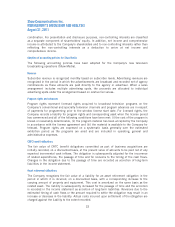Shaw 2011 Annual Report Download - page 26
Download and view the complete annual report
Please find page 26 of the 2011 Shaw annual report below. You can navigate through the pages in the report by either clicking on the pages listed below, or by using the keyword search tool below to find specific information within the annual report.Shaw Communications Inc.
MANAGEMENT’S DISCUSSION AND ANALYSIS
August 31, 2011
Commencing in 2012 free cash flow will not be reported on a segmented basis. Certain
components of free cash flow including operating income before amortization, capital
expenditures (on an accrual basis) net of proceeds on capital dispositions and equipment costs
(net), CRTC benefit funding, and non-controlling interest amounts will be reported on a
segmented basis. Other items, including interest and cash taxes, are not generally directly
allocable to a segment, and will be reported on a consolidated basis. Also commencing in
2012, free cash flow will be determined as above and in addition Shaw will report the changes
in receivable related balances with respect to customer equipment financing transactions as a
cash item, and will adjust for cash funding of pension amounts net of pension expense. Free
cash flow will also be reduced for dividends paid on the Company’s Cumulative Redeemable
Rate Reset Preferred Shares.
STATISTICAL MEASURES:
Subscriber counts, including penetration and bundled customers
The Company measures the count of its customers in Cable and DTH (Shaw Direct). Basic cable
subscribers include residential customers, multiple dwelling units (“MDUs”) and commercial
customers. A residential subscriber who receives at a minimum, basic cable service, is counted
as one subscriber. In the case of MDUs, such as apartment buildings, each tenant with a
minimum of basic cable service is counted as one subscriber, regardless of whether invoiced
individually or having services included in his or her rent. Each building site of a commercial
customer (e.g., hospitals, hotels or retail franchises) that is receiving at a minimum, basic cable
service, is counted as one subscriber. Digital customers include the count of Basic subscribers
with one or more active DCTs. Internet customers include all modems on billing plus pending
installations and Digital Phone lines includes all phone lines on billing plus scheduled
installations due to the growth nature of these products. All subscriber counts exclude
complimentary accounts but include promotional accounts.
Cable measures penetration for basic services as a percentage of homes passed and, in the case
of all other services, as a percentage of Basic customers.
Shaw Direct measures its count of subscribers in the same manner as Cable counts its Basic
customers, except that it also includes seasonal customers who have indicated their intention to
reconnect within 180 days of disconnection.
Subscriber counts and penetration statistics measure market share and also indicate the
success of bundling and pricing strategies.
F. Critical accounting policies and estimates
The Company prepared its Consolidated Financial Statements in accordance with Canadian
GAAP. An understanding of the Company’s accounting policies is necessary for a complete
analysis of results, financial position, liquidity and trends. Refer to Note 1 to the Consolidated
Financial Statements for additional information on accounting policies. The following section
discusses key estimates and assumptions that management has made under GAAP and how
they affect the amounts reported in the Consolidated Financial Statements and notes. It also
describes significant accounting policies where alternatives exist. In addition, within the critical
accounting policies and estimates, Canadian-US GAAP differences are identified where they
exist. Refer to Note 24 to the Consolidated Financial Statements for a complete reconciliation
of Canadian-US GAAP differences. Following is a discussion of the Company’s critical
accounting policies:
22


